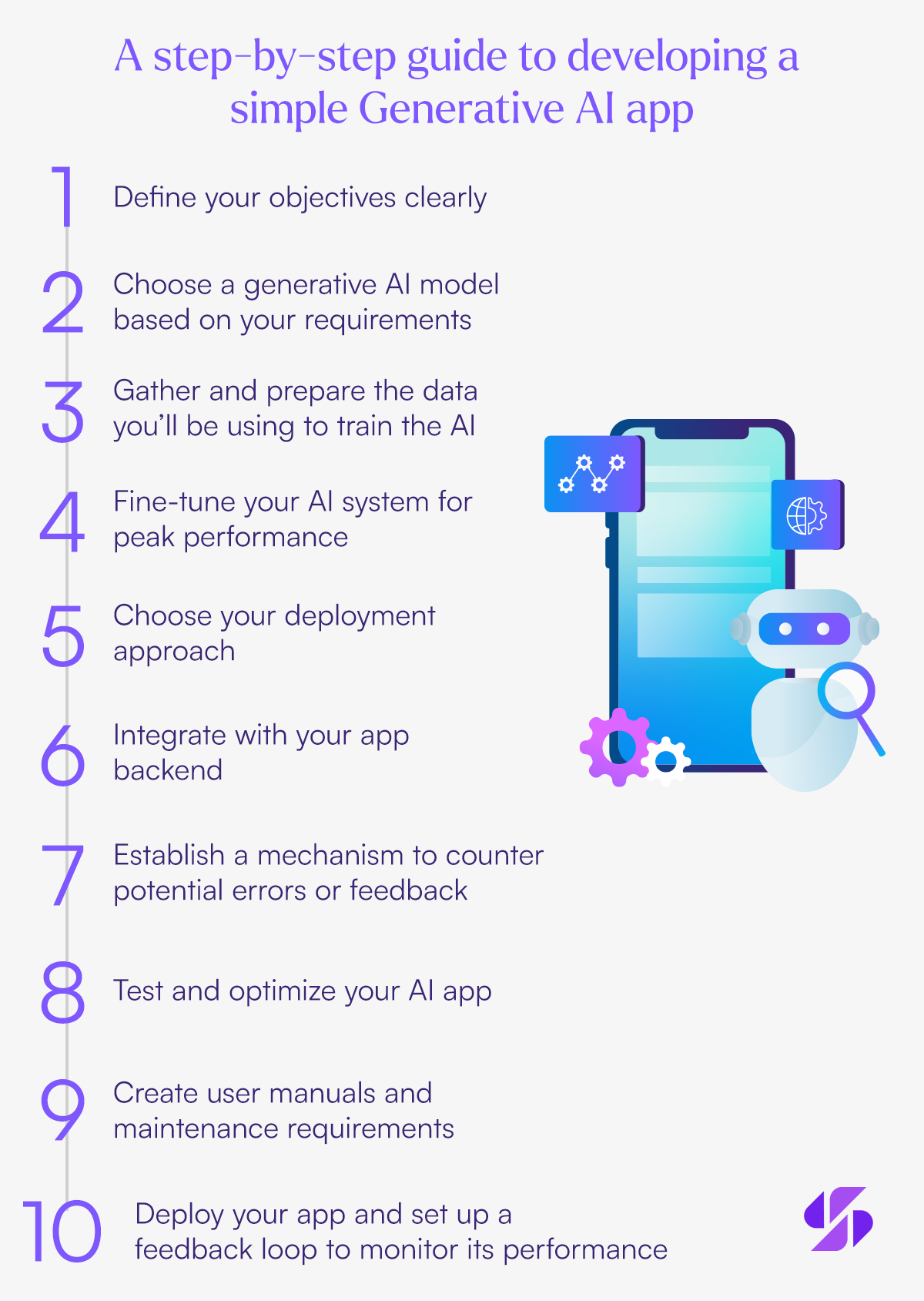Table of content
App development has come a long way in recent years. As AI pushes the boundaries of innovation in software development, generative AI app development has become one of today's biggest buzzwords. In fact, it has the potential to boost business profits by up to $4.4 trillion a year.
AI changes how we conceive and build our apps by unlocking unimaginable possibilities. Using large language models, developers can create intuitive in-app experiences. You also get to personalize user experiences with enhanced creativity.
Read on to find out how the ground-breaking AI technology enhances app development.
How Generative AI differs from other AI technologies
AI has been here for quite some time in the form of machine learning and computer vision. However, these technologies are limited to analyzing and classifying datasets. Generative AI is capable of creating new content based on existing data. This can be in code, text, images, video, music, and more.
Generative AI is currently being used for the development of innovative apps in different industries.
Generative AI can be used to generate code for mobile apps, which can save developers a lot of time and effort. For example, DhiWise has introduced the new feature “WiseGPT” which analyzes the entire codebase to produce personalized production-ready code without writing prompts. The other is the “GitHub Copilot” tool that can generate code snippets and even entire functions based on natural language prompts.
The Role of Generative AI in App Development
Generative AI offers an unparalleled ability to test apps for bugs and errors. AI-based systems not only identify security risks but they can also be used to write code for a wide range of applications.
Enhancing user experience with Generative AI
When it comes to online websites and applications, user experience is crucial. You need to have seamless transitions between different responsive, user-friendly pages. Here, generative AI can automate repetitive tasks in app development.
As a result, it can solve problems without human input. You get an exceptional user experience with a bug-free application that doesn’t require any expert developer insights. That said, the effectiveness of generative AI apps depends on how well you train them.
Personalization and customization through AI
Personalized content is the way to go in the modern world. And nothing creates personalized and customized content like generative AI. By analyzing user history including search and preferences, AI creates personalized recommendations. This enhances the user experience by creating more opportunities for customer engagement.
Generating content and creative elements automatically
When humans work in cross-functional teams, the output is great. Imagine AI doing the same, except with much higher efficiency. Generative AI raises the bar of creativity and innovation. It produces content that would take us too much time to create. Plus, we would need to use various methods and tools to come close.
Automated content generation takes app development to a whole new level. You can now uncover new concepts before even creating the application. Using novel patterns, styles, and combinations, AI allows you to create perfection.
Improving app development with predictive models
Predictive analytics is a field of AI that allows developers to optimize app functionalities. By factoring in the time, effort, and cost of app development, it provides a clear pathway. You can easily identify potential risks and hurdles. It also allows you to eliminate bottlenecks to enhance the functionality of your application. These measures reduce the likelihood of issues arising during the development life cycle.
Looking to Build Your Generative AI App?
Discuss Your Project with shopdev’s AI App Developers
Getting Started with Generative AI App Development
Before getting started with generative AI app development, you need to know its basics. The best practices allow you to be more productive in the process by making it smooth. Whether it's your first time or you’ve been working with AI, here are the steps for app development with generative AI:
Gather high-quality data
No matter how powerful an AI tool is, it still needs to be trained using existing data. The quality of this data determines how well generative AI will perform. Therefore, the first step is to gather error-free and well-structured data. Make sure it does not have any inconsistencies or biases. And of course, it should be relevant.
Training your AI model using high-quality data yields accurate outputs. This makes app development with generative AI worth your while. And your app performs the intended functions with maximum effectiveness.
Choose the right tools and frameworks
Choosing the right algorithms and AI models is among the critical aspects of using generative AI. You need to ensure that you choose the right one based on your specific use case. For example, if you want to generate natural language texts, you can work with algorithms like GPT-4. But if you want images as output, you need a deep learning model like GANs. If you make the right decision, your generative AI app will perform effectively and yield quality outputs.
Understand the data requirements for training AI models
Moving on, you need to ensure that your AI model operates at maximum efficiency. For this, technical know-how of data requirements is crucial. You can adjust the AI’s learning rate, batch size, and epochs, and even regularize it. Here,
- Batch size means how much data it can process at a time.
- Epochs mean the number of times it learns from the data.
- Regularizing means you can prevent it from overthinking or overprocessing data.
Fine-tuning your AI models results in high efficiency of the application.
Develop Your Generative AI App with shopdev
Get in touch with our expert AI app developers today!
Building Your First Generative AI App
Building a generative AI app is a complex process that requires you to follow a unique set of steps. Here’s how you can get started with your first app:

Selecting and preparing your dataset
The process of developing an AI app starts with data. You need to identify the right sources to extract the datasets you’ll be using. This can be done using databases, web scraping, sensor outputs, and APIs depending on your requirements. This is a crucial step as the quality of the data directly affects the performance of your AI model.
Apart from data sourcing, you also need to pay attention to data diversity. The more diverse your data, the better the AI will perform. Its outputs will be more unique if you train it with different scenarios, modalities, and environments.
Training your Generative AI model
This is the step where your efforts shine through. Using the data you’ve gathered and cleaned, you need to train your generative AI model. You’ll be using deep learning and neural networks to feed the prepared data to the AI. It then learns to identify and emulate data patterns.
When the initial model is sufficiently trained, you can proceed to fine-tune the AI. Here, you can go deeper into specific tasks to generate the desired outputs. For instance, you can fine-tune your AI model to create poetry. You’ll have to train it on an extensive dataset of poetic content. Here, you can also deploy techniques like differential learning rates. This process takes different layers of the AI through different learning rates.
Integrate the AI model into your app
Once your AI model is ready to go, the next step is to integrate it into your app. For this, you need to develop APIs or connectors. APIs act as a bridge that fills the gap between your app and the generative AI model. Then, you need to design workflows to ensure that the data generated by AI is integrated into your existing processes. Frameworks like FastAPI and Flask are commonly used to deploy APIs with AI models.
Get Started with Your First AI Application
Consult with shopdev’s AI app developers Today!
Testing and optimizing app performance
Using real-world conditions and comprehensive testing techniques, you need to test the AI app performance. This step helps you determine whether your training in the AI model has been fruitful.
Testing an AI model for performance requires validation and data metrics. With metrics like the ROC curve, AUC score, and error analysis, you need to assess the quality of the AI model's outputs. Moreover, you can compare the outputs with benchmark models to see where your AI model falls behind in terms of accuracy and performance.
Advanced Techniques in Generative AI App Development
Improving Model Accuracy and Efficiency
An AI model is like a work in progress. You can keep making changes and updates to tweak its performance. In the case of app development, you can improve your AI model with the following techniques:
- Retrain the model on better data: You can use newer, more accurate data to retrain your AI. This helps improve performance as the outputs are based on the data being fed into the model.
- Change the way you deploy the model: Sometimes an AI model can struggle to perform well if it isn’t hosted on the right platform or connected to the right hardware.
- Source code enhancement: Some applications are just poorly designed and implemented right from the start. You need to review the source code to make the necessary improvements.
Scale your Generative AI app for a larger audience
Like any other tech solution, AI applications also need to be scalable for future use. Scalability challenges are common in AI app development. For instance, the size of datasets used to train the AI model, the sources used, and the deployment strategy need to be considered.
To make your generative AI app scalable, you need to:
- Ensure that you standardize the development and deployment processes
- Dedicate team efforts to tasks that they know best
- Utilize tools that support creativity, efficiency, and security
- Use development methods that allow updates for the future data
Develop a Future-proof AI App with shopdev
Get in touch with our expert developers today!
Ethical Considerations and Best Practices
For quite some time now, ethical concerns have been raised against generative AI. The most notable concerns like bias and racism were seen when OpenAI’s ChatGPT was first released. For you generative AI app development, you need to consider the following best practices:
- Bias check: Your AI application needs to be checked for unwanted biases that it may have picked up while training on different datasets.
- Fairness: Your AI model must not discriminate or generate biased outputs that negatively impact different user groups
- Anonymization: You need to take care of data privacy when user data is involved. So its important to anonymize your inputs and outputs at all times
Ensure privacy and security in AI-powered apps
Speaking of privacy, there are also reports of concerns related to data encryption. You need to monitor your app’s performance to identify vulnerabilities. Cyber attackers try to take advantage of the same AI capabilities in a negative way. For this reason, you must never include credentials and tokens in the code.
Apart from data encryption and authentication mechanisms, you must implement ongoing vigilance systems to avoid security breaches.
- Create ethical usage guidelines for your AI app.
- Use techniques like adversarial training to restrict bias
- Routinely monitor your AI app’s performance
- Identify and remove fake content, news, and images.
Best practices for transparent and responsible AI usage
Once the ethical and privacy concerns are addressed, you also need to consider transparency in AI usage. For this purpose, you need to implement the following best practices:
- Documentation: Create detailed descriptions of the AI models’s capabilities, its limitations, and how it is expected to perform.
- Feedback loops: You need to have open channels to discuss and mitigate any concerns and questions arising from stakeholders.
- Anomaly detection: Create systems to identify and take care of unintended behaviours or harmful outputs of the AI app.
- Guidelines and policies: The guidelines and policies for AI use must be updated each time a new feature is added or whenever the AI is retrained.
Navigate legal considerations in AI app development
In today’s day and age, the last thing you would want is a non-compliant AI solution. When it comes to legal considerations, you need to look at the following factors:
Copyrights: Businesses have started to use AI applications to create copyright content. As copyrights only protect content created by humans, this causes legal concerns. You need to ensure that your generative AI app cannot be used to create copyright content.
Confidentiality: Similarly, users and businesses are using AI tools for processes that involve personal information. To avoid legal consequences, you need to ensure that the personal data is either anonymized or used safely.
GDPR compliance: According to the GDPR, you need to define the data subjects and the purpose for gathering data. If you are unable to define the purpose, you cannot proceed with the training of your AI models.
The Future of Generative AI in App Development
AI technologies are developing at an alarming rate. Here is what the future holds for AI-based app development:
Emerging trends and technologies in Generative AI
Based on OpenAI’s latest update called GPT-4 Turbo, the system has two core improvements. One is its ability to ‘pull from a newer database of information’. And the second is its promise ‘to follow instructions better’. This gives us an idea of how fast AI is growing and improving.
AI is already working with features we expected it to perform yesterday. So it’s safe to say that the future is already here. AI can now analyze extensive documents and provide you with a summary. This is because it can now support up to 128,000 tokens of context.
That’s not all, as GPT4 Turbo now also has new API assistants. These are aimed at simplifying the creation of AI-driven apps. You will get capabilities like a Code Interpreter, Retrieval, and improved function calling. For app developers, these features are absolute game-changers.
Predictions for the future impact of Generative AI on app development
According to Forrester, ‘generative AI is accelerating the pace of innovation’. If there is going to be a challenge, its going to be navigating the risks of AI. This is because of the exponential rate at which AI is learning. That said, there is good news too. AI will unlock higher levels of productivity in the years to come.
- By 2026, generative AI design will automate 60% of the design effort for developing new websites and mobile apps.
- By 2027, 15% of applications will be automatically generated by AI without human input.
The same research suggests that by next year,
- ‘40% of enterprise applications will have embedded conversational AI, up from less than 5% in 2020’.
- By 2025 ‘30% of enterprises will have implemented an AI-augmented development and testing strategy, up from 5% in 2021.’
Trust shopdev with your AI App Development
Get in Touch with our AI application developers
Key Takeaways
In summary, generative AI has tremendous potential to accelerate application development. It suggests code, identifies bugs, and even refactors lines of code. You can command it to write simple applications to speed up app development. Not only that but you can also perform quality checks of your existing code.
Combined with the innovative ideas brought forth by generative AI, you can achieve higher customer satisfaction. The best part is that generative AI applications are built without ever gathering any requirements.




